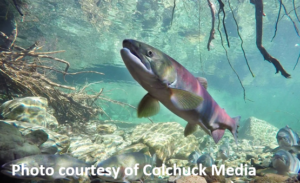Fisheries managers move to protect B-run steelhead
Posted /Uncategorized
Washington, Oregon mull rolling closures, while Idaho adopts wait-and-see policy
- By ERIC BARKER of the Lewiston Tribune
Washington and Oregon are poised to implement rolling closures of the steelhead fishery from the mouth of the Columbia River to the mouth of the Snake this summer and fall in an attempt to protect the dismal B-run, projected to be the lowest on record.
On the Snake River from its mouth to Clarkston, anglers would be required to release all steelhead more than 30 inches in length. The two states also are looking to restrict most fishing on the Snake and Columbia rivers to daylight hours only, and to implement the same rolling closures on the lower sections of Columbia River tributaries, where Idaho-bound B-run steelhead often make short detours while in search of cool water.
Protective regulations for the Snake River upstream of the Idaho-Washington state line at Clarkston and the Clearwater River have not yet been set. Idaho fisheries officials are considering adopting regulations similar to those implemented in 2013, when anglers were only allowed to harvest steelhead less than 28 inches in length.
“We have the advantage in Idaho of seeing the run materialize downriver before we fish,” said Lance Hebdon, salmon and steelhead manager for the Idaho Department of Fish and Game at Boise. “So we’ll keep our options open and implement regulations that are appropriate to meet the objectives of ensuring we meet brood stock targets while maintaining opportunity for our steelhead anglers. Length restrictions are certainly on the table, and we’ll continue to coordinate management with Oregon and Washington.”
Columbia River fisheries managers are forecasting a return of only 7,300 B-run steelhead to Bonneville Dam, including 1,100 wild fish. The fishing restrictions are designed to both protect the wild fish, listed as threatened under the Endangered Species Act, and to ensure enough hatchery fish return for spawning.
“Everybody is going to feel some pain,” said Ron Roler of the Washington Department of Fish and Wildlife at Olympia.
He said Washington and Oregon are adopting a one steelhead bag limit when fishing is allowed. But there will be periods when anglers won’t be allowed to keep any steelhead. Federal permits authorizing the fisheries will allow the two states combined to incidentally kill just 22 wild b-run steelhead during the fishing seasons.
Stuart Ellis of the Columbia River Inter-Tribal Fish Commission said the Columbia River treaty tribes, including the Nez Perce, haven’t yet adopted rules designed to limit take of B-run steelhead during fall chinook gillnet fisheries. But he said the tribal fisheries will be constrained because of the low number of steelhead.
“We will probably have to be a little creative to try to focus fishing on getting the chinook we can get without running into the steelhead limits,” Ellis said.
Under the proposal, nontribal steelhead harvest will be closed during the following dates and locations:
- The mouth of the Columbia River to the Dalles Dam, from Aug. 1 to Aug. 31.
- The Dalles Dam to John Day Dam, from Sept. 1 to Sept. 30.
- John Day Dam to McNary Dam, from Sept. 1 to Oct. 31
- McNary Dam to the Oregon-Washington state line, from Oct. 1 to Nov. 30.
- The lower reaches of the Cowlitz, Lewis, Wind, White Salmon and Klickitat rivers, as well as Drano Lake, will be closed to steelhead harvest from Aug. 1 to Aug. 31.
- The lower Deschutes River from Moody Rapids to its mouth will be closed to all fishing from Aug. 1 to Aug. 31.
- The John Day River, downstream of Tumwater Falls, is expected to be closed from Sept. 1 to Oct. 31.
In many locations, only anglers targeting northern pikeminnow will be allowed to fish at night.
Roller said the closures are designed to be in place at the times B-run steelhead are present in different river sections and intended to reduce the number of anglers targeting steelhead.
“We are in a serious hurt here so we have to take some serious measures to curtail fisheries on steelhead.”
Jeromy Jording, biologist with the National Oceanic and Atmospheric Administration, said the record-low flows and elevated water temperatures during the spring and summer of 2015 combined with the warm mass of water off the coast of Washington that year – known as the Blob – is responsible for the dire prediction, as well as this year’s poor return of spring chinook. Last year, the collapse of the A-run also was blamed on the poor river and ocean conditions of 2015.
“This is the lowest return we have forecasted I think on record,” he said. “Even if you go back into the 1990s, this year would be even lower than anything we observed during that poor period of survival.”
Jording said climate change could cause greater frequency of the kind of drought and poor ocean conditions responsible for this year’s poor steelhead showing.
“The effects of climate change give us a great cause for concern on how we can expect run size abundance to behave in the future,” Jording said.
